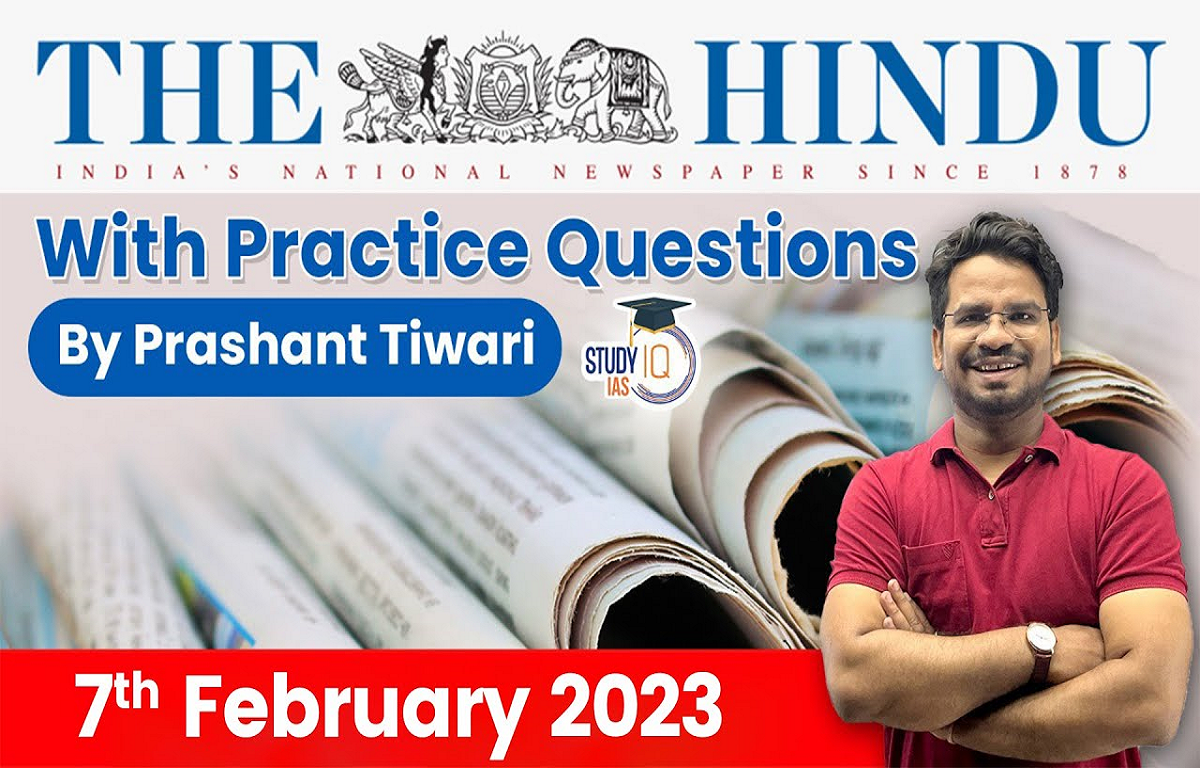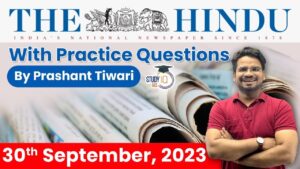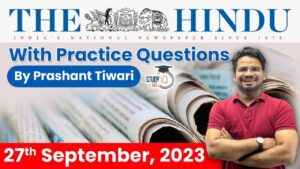The Hindu Newspaper Analysis for UPSC
- The open prison model adopted in Rajasthan, with convicts staying on community land without high walls or strict surveillance, has promoted a reformative form of punishment and succeeded in transforming the lives of inmates. Once a pioneering idea, Rajasthan has now proved its success with 40 such open camps.
- Prisoners who have served one-third of their sentences are eligible to shift to the open jails, according to the Rajasthan Prisoners’ Open Air Camp Rules of 1972. Inmates of Central and district jails with a track record of good conduct are regularly identified to make the move to the open prisons, where they are allowed to live with family members and earn their livelihoods.
- The trust-based concept, introduced in the State in the 1950s, has succeeded by facilitating the integration of prisoners into society by ensuring their stay in a functional social environment.

- The shooting down of a Chinese surveillance balloon by the U.S. military has served as a stark reminder of the deep distrust that characterizes relations between the world’s two biggest powers.
- The detection of the balloon last week over Montana sparked a diplomatic crisis, leading to U.S. Secretary of State Antony Blinken calling off a highly anticipated visit to China from February 6. The visit, which would have been the first by a top U.S. diplomat since 2018, was the result of a months-long effort to halt the downward spiral in ties, coming out of the Biden-Xi meet in November at the G-20 Bali summit.
- Beijing has maintained that the balloon was “civilian” (meteorology), but had drifted off-course. It also slammed the move to shoot it down as an overreaction.
- S. officials have acknowledged this was by no means the first such surveillance balloon spotted over American skies; there was a similar incident under the Trump administration. Balloons were also spotted over Japan in 2020 and 2021, and over India’s Andaman Islands last year.
- In 2001, the U.S. and China were able to dial down tensions after a collision between a U.S. spy plane and a Chinese fighter jet over Hainan island in China. Should a similar crisis now arise, particularly against the charged backdrop of an intensifying rivalry, muscle-flexing over Taiwan, and a heated domestic discourse, finding an off-ramp will be far more difficult.


- When the Supreme Court granted legal status to the concept of ‘advance medical directives’ in 2018 and allowed passive euthanasia, subject to stringent safeguards, it was seen as a vital recognition of both patient autonomy over end-of-life decisions and the right to a dignified death.
- In a recent order, a Constitution Bench modified the directions to make them more workable and simple. The advance directive no more needs to be countersigned by a judicial magistrate. Instead, it could be attested before a notary or a gazetted officer.
- The new guidelines require the hospital itself to constitute a primary medical board to certify whether the instructions on refusal or withdrawal of treatment should be carried out.
- The hospital should also form a secondary board, including a doctor nominated by the district’s chief medical officer, which will have to endorse the primary board’s certificate. The change here is that the district Collector need not constitute the second medical board, as required in the 2018 judgment.
- The requirement for the Magistrate’s approval has been replaced by an intimation to the Magistrate. The medical board must communicate its decision within 48 hours; the earlier guidelines specified no time limit.
First, what is euthanasia, and what is a living will?
- Euthanasia refers to the practice of an individual deliberately ending their life, oftentimes to get relief from an incurable condition, or intolerable pain and suffering. Euthanasia, which can be administered only by a physician, can be either ‘active’ or ‘passive’.
- Active euthanasia involves an active intervention to end a person’s life with substances or external force, such as administering a lethal injection. Passive euthanasia refers to withdrawing life support or treatment that is essential to keep a terminally ill person alive.
- Passive euthanasia was legalised in India by the Supreme Court in 2018, contingent upon the person having a ‘living will’ or a written document that specifies what actions should be taken if the person is unable to make their own medical decisions in the future.
- In case a person does not have a living will, members of their family can make a plea before the High Court to seek permission for passive euthanasia.

- Maturity, in a human, is the duty to conduct oneself in accordance with social norms, under varying circumstances, irrespective of how the individual feels.
- In the context of a nation, Tocqueville defines the maturity of a nation as the capacity of the people of that nation to act responsibly in the face of social flux.
- The rapid growth in national power, along with the unbridled freedom of economic power, has given Indians something that our predecessors never had. Simultaneously, the tide of events that has rocked the world has not passed by India. So, has India behaved responsibly in light of all this? Is India mature?
- Let us test this from the perspective of the freedom of speech.
- The freedom of speech is one of the most cherished freedoms. The Constitution of India, too, declares that Indians possess this freedom, but makes it subject to the interest of public order, or the sovereignty and integrity of India.
- The concept of freedom of speech is a western notion. While some form of freedom may have existed in ancient Greece, the real freedom of speech, as we understand it today, was propounded by Voltaire and Rousseau.
- R. Ambedkar, in his Writings and Speeches, notes this in relation to ancient India: “‘As to freedom of speech it exists. But it exists only for those who are in favour of the social order. The freedom is not the freedom of liberalism which was expressed by Voltaire when he said ‘I wholly disapprove of what you say and will defend to the death your right to say it.”’
- There is some evidence that the freedom of expression existed within state-ordained constructs. The content of the debates of Adi Shankara or Saint Thirugnana Sambandar seem remarkably liberal. Yet, this freedom did not extend to criticism of the king or his royal policies.
- Indians seek to shut down the opinions and expressions of others when they feel threatened by it. This sense of insecurity along with aggression is the hallmark of adolescence and runs as a common thread through all the oppressive actions we have noticed above.
- Most recently, the Supreme Court of India in its judgment in Kaushal Kishore’s case (rendered on January 3, 2023) declared that the fundamental rights of Indians are exercisable not only vertically but also horizontally. The question before the Court in this case was whether the fundamental rights (including the freedom of speech) can be claimed other than against the state or its instrumentalities. The Court concluded that such fundamental rights can be enforced even against persons other than the state and its instrumentalities.

- The allocation for MGNREGA in the Budget is ₹60,000 crore. This is less than 0.2% of the GDP, the lowest ever allocation as a percentage of GDP. World Bank economists had estimated that the allocation should be 1.6% of the GDP.
- MGNREGA is a demand-driven law. Every household must get work within 15 days of demanding work, failing which the workers are legally entitled to an unemployment allowance.
- Getting work and wages is contingent on the household details being entered on the MGNREGA software called the Management Information System (MIS). The MIS has been used to subvert the Act in many ways, one of which is work demand suppression. Owing to budgetary constraints, officials usually give fewer days of work to many households or provide many days of work to a few households.

- In a major milestone, the naval variant of the indigenous light combat aircraft (LCA) landed on the first indigenous aircraft carrier, INS Vikrant, on Monday. This is also the maiden landing of a fixed-wing aircraft on the carrier. The LCA’s feat was followed by the landing and take-off by a twin-engine MiG-29K fighter jet.
- “A historic milestone achieved towards Aatmanirbhar Bharat [self-reliant India] by the Navy as naval pilots carry out landing of LCA [Navy] onboard INS Vikrant,” Navy spokesperson Commander Vivek Madhwal said. “It demonstrates India’s capability to design, develop, construct and operate IAC with indigenous fighter aircraft.”
- Madhwal further added: “Indian Navy takes a significant step towards operationalising the IAC by successful landing of MiG-29K on INS Vikrant by naval pilots…”
Q) Visva Bharati university, recently seen in news lies in which state?
- Bihar
- Madhya Pradesh
- Karnataka
- West Bengal
हाल ही में खबरों में रहा विश्व भारती विश्वविद्यालय किस राज्य में स्थित है?
- बिहार
- मध्य प्रदेश
- कर्नाटक
- पश्चिम बंगाल
About Visva Bharati university:
- It is one of India’s major Central Government funded autonomous university located in Santiniketan, West Bengal.
- It is well-known as a distinguished centre for Visual Art practice and research in India.
- The university was established in 1921 by Nobel Prize Laureate, Rabindranath Tagore.
- It was named after Nobel Laureate Rabindranath Tagore until Visva-Bharati Society was registered as an organisation in May 1922.
- The institution was given the status of Central University in 1951 through a central Act.
- Its first vice-chancellor was Rathindranath Tagore, the son of Rabindranath Tagore, and the second vice-chancellor was grandfather of another Nobel Laureate economist Amartya Sen.
- The President of India appoints the Vice-chancellor of the University.
- Visva Bharati University is renowned for its cultural festivals called Poush Mela and the Basanta Utsab which attracts a number of artisans from all across the country.
Q) Consider the following statements regarding the Organisation for Economic Co-operation and Development (OECD)?
- It is an international organisation of 38 countries committed to democracy and the market economy.
- India became a member of OECD in 2019.
Which of the above statements is/are correct?
- 1 only
- 2 only
- Both 1 and 2
- Neither 1 nor 2
आर्थिक सहयोग और विकास संगठन (OECD) के संबंध में निम्नलिखित कथनों पर विचार करें?
- यह लोकतंत्र और बाजार अर्थव्यवस्था के लिए प्रतिबद्ध 38 देशों का एक अंतरराष्ट्रीय संगठन है।
- भारत 2019 में ओईसीडी का सदस्य बना।
उपरोक्त कथनों में से कौन-सा/से सही है/हैं?
- केवल 1
- केवल 2
- 1 और 2 दोनों
- न तो 1 और न ही 2
Key facts about Organisation for Economic Co-operation and Development (OECD):
- It is an international organisation of 38 countries committed to democracy and the market economy.
- OECD members are typically democratic countries that support free-market economies.
- The OECD was established on Dec. 14, 1960, by 18 European nations, plus the United States and Canada.
- Headquarters: Paris, France.
- The stated goal of the Organisation for Economic Co-operation and Development (OECD) is to shape policies that foster prosperity, equality, opportunity and well-being for all.
- The OECD publishes economic reports, statistical databases, analyses, and forecasts on the outlook for economic growth worldwide.
- The organization also seeks to eliminate bribery and other financial crime worldwide.
- The OECD maintains a so-called “black list” of nations that are considered uncooperative tax havens.
- India is one of the many non-member economies with which the OECD has working relationships in addition to its member countries.
Q) With reference to Guru Ravidas, consider the following statements:
- He was a 14th-century famous Bhakti Movement saint.
- He believed in the nirguna form of devotion.
Which of the above statements is/are correct?
- 1 only
- 2 only
- Both 1 and 2
- Neither 1 nor 2
गुरु रविदास के संदर्भ में निम्नलिखित कथनों पर विचार कीजिये:
- वे 14वीं शताब्दी के प्रसिद्ध भक्ति आंदोलन संत थे।
- वे भक्ति के निर्गुण रूप में विश्वास करते थे।
उपरोक्त कथनों में से कौन-सा/से सही है/हैं?
- केवल 1
- केवल 2
- 1 और 2 दोनों
- न तो 1 और न ही 2
Explanation :
The President of India greeted fellow citizens on the eve of the birthday of Sant Guru Ravidas.
- Guru Ravidas Jayanthi is commemorated on Magh Purnima, the day of the full moon in the month of Magh, according to the Hindu Lunar calendar.
- Guru Ravidas was a 14th-century famous Bhakti Movement saint.
- He abandoned saguna (with attributes, image) forms of supreme beings, and focussed on the nirguna (without attributes, abstract) form of supreme beings.
- Ravidas was a disciple of Sant Kabir and the founder of the Ravidassia religion.
- The Sikh scripture, Guru Granth Sahib, contains forty-one of his devotional songs and poems.
Q) With reference to the Hubble Space Telescope, consider the following statements:
- It was launched by the European Space agency.
- It was launched into low Earth orbit.
Which of the above statements is/are correct?
- 1 only
- 2 only
- Both 1 and 2
- Neither 1 nor 2
हबल स्पेस टेलीस्कोप के संदर्भ में निम्नलिखित कथनों पर विचार कीजिये:
- इसे यूरोपीय अंतरिक्ष एजेंसी द्वारा लॉन्च किया गया था।
- इसे पृथ्वी की निचली कक्षा में प्रक्षेपित किया गया था।
उपरोक्त कथनों में से कौन-सा/से सही है/हैं?
- केवल 1
- केवल 2
- 1 और 2 दोनों
- न तो 1 और न ही 2
Explanation :
Recently, astronomers used NASA’s Hubble Space Telescope to directly measure the mass of a single, isolated white dwarf star.
- It is named in honour of the trailblazing astronomer Edwin Hubble and was launched by NASA. Hubble lies in a circular Low Earth Orbit at roughly 559 km altitude.
- It is a large, space-based observatory, which has revolutionized astronomy since its launch and deployment by the space shuttle Discovery in 1990.
- Hubble’s domain extends from the ultraviolet through the visible (which our eyes see) and into the near infrared.
- It is one of NASA’s Great Observatories Programs. The other missions in the program include the visible-light Spitzer Space Telescope, Compton Gamma-Ray Observatory (CGRO), and the Chandra X-Ray Observatory (CXO).
Q) Consider the following statements regarding Follow on Public Offer (FPO):
- It is the first sale of shares to the public by a privately owned company.
- Companies use FPOs to diversify their equity base and raise capital for business.
Which of the above statements is/are correct?
- 1 only
- 2 only
- Both 1 and 2
- Neither 1 nor 2
फॉलो ऑन पब्लिक ऑफर (एफपीओ) के संबंध में निम्नलिखित कथनों पर विचार करें:
- यह किसी निजी स्वामित्व वाली कंपनी द्वारा सार्वजनिक रूप से शेयरों की पहली बिक्री है।
- कंपनियां अपने इक्विटी आधार में विविधता लाने और व्यापार के लिए पूंजी जुटाने के लिए एफपीओ का उपयोग करती हैं।
उपरोक्त कथनों में से कौन-सा/से सही है/हैं?
- केवल 1
- केवल 2
- 1 और 2 दोनों
- न तो 1 और न ही 2
About Follow on Public Offer (FPO):
- What is it? FPO is a process wherein a company already listed on a stock exchange issues new shares to existing investors or shareholders.
- It is also known as a secondary offering.
- Purpose:
- FPO allows a company to raise additional funds through the issuance of new shares.
- Companies use FPOs to diversify their equity base and raise capital for business.
- This capital can be used for multiple purposes, such as to meet the company’s expenses, business expansion, debt reduction, etc.
What is Initial Public Offer (IPO)?
- When a private company first sells shares of stock to the public, this process is known as an initial public offering (IPO).
- An IPO means that a company’s ownership is transitioning from private ownership to public ownership.
Mains Practice Question:
Q) Has the formation of linguistic states strengthened the cause of Indian unity? (2016) (250 words)
क्या भाषाई राज्यों के गठन ने भारतीय एकता के कारण को मजबूत किया है? (2016) (250 शब्द)


 The Hindu Newspaper Analysis 6 October 2...
The Hindu Newspaper Analysis 6 October 2...
 The Hindu Newspaper Analysis 30 Septembe...
The Hindu Newspaper Analysis 30 Septembe...
 The Hindu Newspaper Analysis 27 Septembe...
The Hindu Newspaper Analysis 27 Septembe...





















